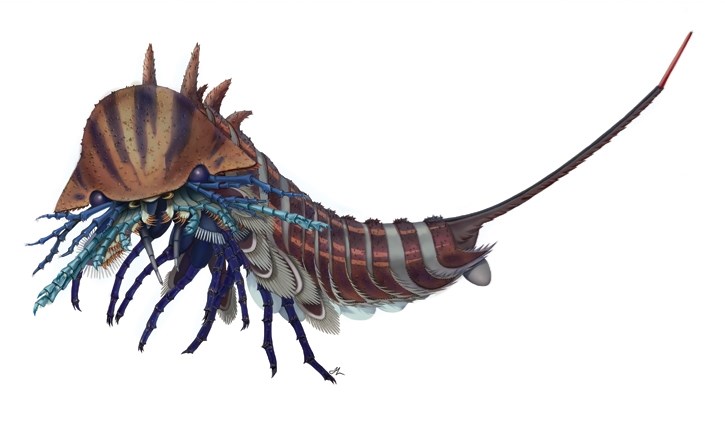Tiny but fierce is how paleontologists are describing a newly-identified, but not newly-discovered, fossilized creature from the Burgess Shale fossil bed in Yoho National Park.
At two centimetres long Habelia optata truly is tiny, but Cédric Aria, a post-doctoral researcher at China’s Nanjing Institute of Geology and Palaeontology, and Jean-Bernard Caron, senior curator of invertebrate palaeontology at the Royal Ontario Museum (ROM), write in a recent study published in BMC Evolutionary Biology that Habelia’s unique mouthparts would have been used to tear apart shelled creatures such as trilobites.
“This complex apparatus of appendages and jaws made Habelia an exceptionally fierce predator for its size,” said Aria in a release from the ROM. “It was likely both very mobile and efficient in tearing apart its prey.”
And it’s the mouthparts – hard appendages that look much like the mandibles of an ant, a lobster, or a centipede – along with much of Habelia’s anatomy that led paleontologists on something of a wild-arthropod chase over the past century.
American scientist Charles Doolittle Walcott found Habelia specimens in 1912, three years after he discovered the fossil bed located on Fossil Ridge along the slopes of Wapta Mountain. Walcott attempted to identity Habelia but was unable to come up with a firm diagnosis.
Subsequent researchers also attempted to figure out where Habelia sat among arthropods, but with no luck. So, like many Burgess Shale creatures, Habelia was set aside as a problem to be solved another day.
And that day has finally arrived, thanks to modern diagnostic technology, a greater understanding of the Burgess Shale’s 508-million-year-old fossils and a willingness to tackle persistent challenges: 106 years after Walcott discovered Habelia, Aria and Caron now believe Habelia is the distant ancestor of spiders, scorpions and horseshoe crabs, a group of arthropods known as chelicerates.
Chelicerates are recognized by their appendages, known as chelicerea, the tiny pincers of a scorpion or horseshoe crab or the jaws of a spider, for example. These appendages are located near their mouth and are used for cutting or piercing their food. Spiders’ chelicerea contain venom glands and are tipped with fangs.
While the fact Habelia is an ancient relative of chelicerates is interesting, where Habelia moves from interesting to intriguing – and the reason why it’s taken paleontologists so long to accurately identify it – is that it has the same features, or body plan, as Cambrian mandibulates.
Mandibulates, a sub-group of arthropods that includes insects, crustaceans, centipedes and millipedes, are distinguished by antennae and mandibles, which are used to squeeze and crush their food.
Habelia, meanwhile, has all the familiar markings of an arthropod with an exoskeleton, jointed legs and a segmented body.
It also has appendages that function in the same manner as mandibles, antennae and maxillipeds, which crustaceans (also mandibulates) like lobsters use to process food. None of those features are found on chelicerates.
Although Habelia’s unusual features function like those of a mandibulate, it was a pair of chelicerae-like appendages and the overall anatomy of its head that led Aria and Caron to conclude Habelia is a distant relative of spiders, scorpions and horseshoe crabs.
Given Habelia’s mandibulate-like features, Aria and Caron write that Habelia provides a unique example of an evolutionary process known as convergence where different animals living in the same environment evolve similar characteristics.
The authors write that both mandibulates and Habelia evolved to take advantage of the proliferation of animals with hard shells, or carapaces, such as trilobites.
“This builds on the importance of carapaces and shells for evolutionary change during the Cambrian explosion, and expands our understanding of ecosystems at this time, showing another level of predator-prey relationship and its determining impact on the rise of arthropods as we know them today,” wrote Caron in the ROM release.
“The appearance and spread of animals with shells (is) considered to be one of the defining characteristics of the Cambrian explosion, and Habelia contributes to illustrate how important this ecological factor was for the early diversification of chelicerates and arthropods in general.”
The researchers studied 41 specimens, most of which were collected in Yoho National Park. Their study describing Habelia, Mandibulate convergence in an armoured Cambrian stem chelicerate, was published in the journal BMC Evolutionary Biology in Dec. 2017.




